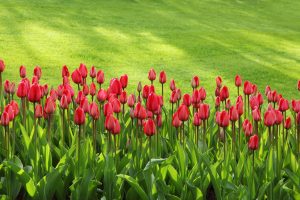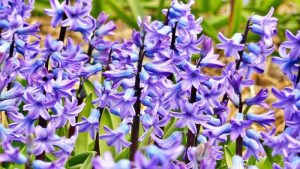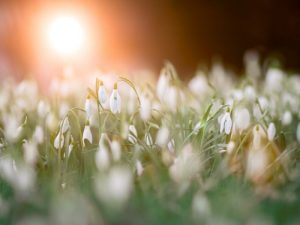Shake away the winter blues by planting your early spring flowers ahead of the spring season. These plants will lighten your spirit and add extra beauty to your spring garden with their lovely colors.
And the most incredible part? You don’t have to await the departure of the last snow since most of these early spring flowers can survive the snow to put forth their beauty.
Before we dive into the various early spring flowers, here are a few tips to help you ensure a healthy spring flower garden and, of course, the much-desired attractive landscaping design.
Before You Plant These Spring Flowers, Garden Care, First!
Clear Your Garden:
The long dreary winter season will most likely get you additional work on your garden (which majorly entails the removal of debris such as leaves and the leftover snow). So get ready with your garden tools.
Weeding:
Ensure the complete removal of weeds (plus their roots) to prevent their regeneration.
Rehydrate the Soil Before Planting Spring Flowers:
Rekindle the moisture content of your garden. Winter is when your garden plants suffer the most as the cold weather freezes the soil, making it difficult for the roots to take up water.
The result?
Plants die out due to lack of moisture. However, it’s also the ideal planting season, especially if you live in areas that experience less freezing. Therefore, consider adding mulch and organic materials such as manure to help moisturize your garden soil and ensure the prolonged lifespan of your plants.
Prune Your Existing Plants:
Pruning is an ideal method to keep your garden healthy and beautiful as it ensures the enhanced quality of your spring flowers, shrubs, and fruits. It’s one of the most effective ways of managing a flower garden. Pruning enables you to control the number and size of flowers on your trees and landscaping design, allows for the natural control of pests and diseases while also boosting your plants’ health.
Note: Ensure you do the pruning at the right time, and if unsure of the timing and the technique to be used, consider doing online research.
Now it’s time to revamp your flower garden with new spring flowers, and below is a list of plants to choose from: The Early Spring Flowers
18 Early Spring Flowers for Your Yard
1. Tulip

Winter may be the dullest season you ever have to experience; however, the bright and warm-colored tulip flowers sweep all the blues away as it announces the official onset of spring. The flower comes in various colors (most commonly red, yellow, white, and pink) and does well in full sun, well-drained and fertile soil—which should be neutral or slightly acidic.
Sandy or dry soils grow the best of tulips because these flowers dislike excessive moisture. Experience the magic of tulips throughout the spring by planting varieties—which of course, come with different blooming times. Up to declaring your love to someone special to you? Then manifest it in how you treat and care for your tulips.
Remember, red tulips are a symbol of love declaration.
Care Tip:
Water them right after planting to trigger growth and stop until the leaves emerge—when you can now lightly sprinkle your plants. Since tulips are good at storing nutrients, consider fertilizing them at the onset of the Fall season and at the beginning of the Spring to ensure vigorous growth.
2. Hyacinth

Hyacinth flowers are popularly known for their highly fragrant nature and how they blossom (usually in dense clusters).
They’re often planted outdoors directly into the ground soil; but can also be grown in container gardens and made to flower indoors, especially during the winter season. Generally, these flowers grow well in moderately fertile and well-drained soil with exposure to the full sun. You can still grow them outdoors under partial shade.
Consider loosening the soil before planting, and after that, water thoroughly to moisten the soil. This care is unlike in the transplant case—where you need to water sparingly and stop until the flower buds emerge in the following year.
Note: Wear gloves if you intend to handle hyacinth bulbs for an extended period since they contain oxalic acid—a substance that can cause severe irritation to your skin.
Care Tip:
Though the care tips may vary depending on where you choose to grow your hyacinth (either in a container or in the ground), a few tips cut across, and they include: Allow your hyacinth bulbs the much-needed breathing space by cutting down on the amount of water you feed them. In any case, excessive moisture leads to bud rot while also providing a conducive environment for the thriving of gray mold. Cut back your hyacinth flower stalks late in the spring (after they finish flowering) to redirect the plant’s efforts into energy storage in the bulb. Only remove the leaves when they begin to turn yellow or leave them to die off naturally since this helps to keep the bulb nourished for the following year.
3. Daffodil

These easy-to-grow perennials are usually trumpet-shaped and come in various colors (including white, yellow, and orange) to officially announce the arrival of spring.
Though you can grow daffodils in a range of soils, they thrive best in moderately fertile and well-drained soil with adequate moisture throughout the growing season. The site should also offer full exposure to the sun or partial shade.
Just like hyacinth bulbs, daffodil bulbs contain oxalic acid, which can cause skin irritation, popularly referred to as “daffodil itch.” Therefore, it’s recommended that you wear gloves before handling the bulbs.
Also, watch out that your pets may not munch on the bulbs as they’re poisonous. Despite their toxic nature, daffodils are usually a symbol of hope and also symbolize the 10th wedding anniversary.
Care Tip:
Deadhead your daffodils as the flowers fade but leave on the leaves for at least six weeks to allow for the plants’ rejuvenation. Since these plants exhibit leafless stems, the pressure from the one to twenty blooms can sometimes appear to weigh down the stems. In such a case, consider staking up the flowers.
4. Snowdrop Flower

Snowdrop is usually the year’s first flower to showcase its beauty, with its blossoming symbolizing the end of wintertime and the beginning of yet another active season. It’s among the few plants able to withstand the chill of the winter—which is courtesy of the heat it produces, and thus able to melt down the snow around it.
Snowdrop flowers do well in well-drained soil with plenty of humus and don’t necessarily require too much other care; all they need is adequate water.
Consider planting them 2-3 inches apart for a showy spring display. They tolerate full sun to partial shade, making them a natural choice for moon and woodland gardens.
Care Tip:
Avoid planting snowdrop bulbs in singles; instead, do the planting in small groups to enable the forming of a perfect snowdrop blanket. This will help remove the snow blanket that comes with the dreary winter season.
5. Redbud Tree
Want some brilliant color on your landscape? Then the redbud tree is all you need. They’re easy to maintain, and their mauve-pink blossoms that last 2-3 weeks work perfectly for any landscaping project.
Whether you choose to have them in your woodland garden or just as a shrub border—redbud trees will do the magic of restoring the charm of your spring garden. All they need is a partially shaded location with well-drained soil. Plant them in early spring and water thoroughly immediately after planting.
Care Tip:
Consider pruning your redbud tree in the fall to ensure a natural growth habit. Since the plant requires adequate moisture for its establishment, consider placing some mulch around the tree (3 inches will do); however, ensure it doesn’t touch the trunk.
6. Bleeding Heart
With their heart-shaped flowers that always take red, white, or pink colors, bleeding hearts are a natural beauty in the spring. They’re good additions to your shade garden or woodland planting, as they partly require the sun and the shade.
Consider planting them in moist and well-drained soil with a spacing of 1-2 feet apart. Since they enjoy humus-rich soil and consistent moisture, ensure you add them some compost layer in the spring to boost their growth.
Bleeding hearts are entirely poisonous plants; however, their seed (which contains elaiosome—a rich source of lipids) act as one of the ants’ favorite foods. No wonder the ants play a significant role in dispersing the bleeding heart plant seeds.
Care Tip:
Water the plant often to keep the soil consistently moist. Organic soil is its best feeding source, and partial shade helps it survive.
7. Azalea
These easy-to-care-for shrubs come in a wide variety of beautiful colors (ranging from the velvety lavender and luscious peach to the brilliant and triumphant pink), thus making choosing one over the other almost impossible.
They exhibit shallow roots and grow best in well-drained and organically enriched acidic soil. Consider planting them in the spring in a cool, lightly shaded site to prevent the sun from burning their leaves.
Also, note that too much shade can deprive azalea shrubs of the much-needed oxygen, thus leading to weaker growth which then triggers poor blooming.
Care Tip:
Water your azalea plants regularly until they’re established. Focus on the plant’s foliage and the roots to ensure adequate water absorption. Water them in the morning to allow the leaves time to dry during the day. This reduces the risk of mold growth in the night. Prune your azaleas only when necessary.
8. Pansy
Pansies are usually referred to as “face” flowers owing to their bright petals and designs that tend to take various shapes. Some see the petals’ designs as beards, while others say they’re wings.
These flowers like the sun and do well in cold weather, hence ideal for both fall and spring gardens. Their easy-to-go-with nature makes them a good fit for all your gardening plans, including using them as ground covers, borders, or even planting them in containers.
Ensure the soil is well-drained, moist, and humus-rich for optimum pansy growth and quality blooms.
Care Tip:
Water your pansies regularly to enhance their growth. Consider removing the dead flowers to extend the blooming period and trigger more flower growth.
9. Crocus
Crocuses, like snowdrop flowers, push through the blanket of snow to announce spring’s arrival earliest.
Their strong perfumes and the varied, beautiful colors (including red, orange, yellow, pink, and many others) quickly erase the dull look that winter leaves on your landscape while attracting bees for enhanced pollination.
Maybe the biggest challenge you’ll experience with these flowers is chasing off the predators. Rabbits, deer, and squirrels enjoy the corms and flowers of these plants. However, interplanting them with daffodils dramatically helps to keep the animals away, as they dislike the plant.
Consider growing your crocuses in well-drained soil with a neutral pH of six or seven. Remember, they require full sun to thrive. These plants dislike sitting in wet soil, especially during their summer dormancy periods.
Care Tip:
Water your crocuses regularly in the spring and fall instead of the summer, when they prefer a drier soil. Allow the leaves to die back naturally post-bloom, enhancing the plants’ rejuvenation process. Crocuses are prone to virus attacks which can lead to streaking and cases of stuck buds (these are buds that fail to open). In such a case, consider disposing of the attacked plants to prevent further spread of the disease. Note: So far, there isn’t an established cure for viral diseases.
10. Lily of the Valley
These highly fragrant plants usually bloom in the spring and early summer and exhibit tiny white bell-shaped flowers—which beautifully protrude over the plant’s light green and lance-shaped leaves.
Lily of the valley plant thrives in moist soil and mostly prefers partial shade, though they can easily adapt and do well in dry shade.
Late fall is usually the best time to plant these flowers to enable them to catch up with the chilly winter temperatures. The cold temperature allows for a proper dormancy period.
You don’t want to harm your children and pets, so keep them away while you execute the planting since lily of the valley plant is known to be poisonous.
Care Tip:
Since they spread very fast, it would be best to have your lily of the valley plants outdoors (either in containers or in a naturalistic garden) for easy management and to ensure they enjoy optimum moisture levels.
11. Johnny Jump Up:
Despite their small and delicate nature, Johnny Jump-Up flowers make the most significant statement with their bright purple and yellow blooms, which stand out in the spring.
You can never go wrong with such beauties if you’re up to sprucing up your landscape with additional warm colors. Dig in sufficient compost to help enrich the soil and scatter the seeds over the already prepared ground.
Lightly cover the seeds and water until they germinate. Johnny Jump Up plants grow well with adequate sunlight but thrive with partial sun. They’re easy to maintain and edible – excellent salad and cocktail additions.
Care Tip:
Keep the flowers watered; however, ensure you don’t over-moisten the soil. Consider removing the dead flowers to allow for more blooming and bushier growth.
12. Grape Hyacinth
Grape hyacinths usually grow to a maximum height of 6-12 inches with purplish-blue flowers resembling some tiny beads strung and growing together in clusters of 12-20—usually up and down the plant’s stem.
Amazingly, they’re always the first nutrient source for various insects, including the bees in the spring. Grape hyacinths don’t like extreme conditions, so you should plant them in well-drained ordinary garden soil with adequate exposure to the sun, though they can still thrive in half-shaded locations.
Extreme wetness or dryness can easily lead to fouling and an increased risk of bulb attack by the molds.
Grape hyacinth can be quite invasive; therefore, consider planting the bulbs in a spacious area where they can spread freely.
Care Tip:
Consider plucking off the plant’s flower heads (right before the seeds are produced) once the flowers begin to fade to allow the bulb more strength to propagate. But this is optional as you can still leave the plant to grow wild with the seeds.
13. Paperwhite Narcissus
These flowers are often a clear reminder of the warm spring season in the waiting when winter seems to reign over the other plants.
Paperwhites can only be grown in the ground in the warmest parts of the U.S.—always found in the USDA zones of 8 and above.
However, you can still produce the bulbs indoors in your container gardens. Just ensure that the soil in your container is well-drained and place the pot in a cool and low-lit site, of course, after lightly covering the bulbs with soil. Bring them to a bright sunny location once they shoot.
If planted outdoors, the paperwhites should be exposed to the full sun as they require lots of sunlight for enhanced growth.
Care Tip:
Add compost to your garden before planting your paperwhites to boost their growth.
14. Japanese Cherry Blossom Tree
Besides their pretty pinkish color (always associated with the spring season), cherry blossom flower petals are also edible and brew perfect Japanese traditional sakura tea.
These blooms symbolize hope and renewal among the Japanese, who treasure it as their national flower. Most importantly, it’s often celebrated as a symbol of friendship between the U.S. and Japan.
With their peak blooming season every April 4, these flower trees require full sun, not scorching sites. Consider growing them in well-drained soil for optimum growth levels.
Care Tip:
Consider growing your cherry blossom tree on a terrace, balcony, or in a pot. The container should have a hole at the bottom to drain any excess water. Prune the tree only after the blooming season.
15. Rhododendron
Rhododendrons are among the few evergreen shrubs with broad leaves. They are known for their brilliant flowers that bloom in the spring.
They stand out in the whitish-colored winter season with their unfading evergreen leaves to announce life in the seemingly dormant part of the earth. Like most spring flowers, rhododendrons grow best in well-drained, moist, humus-rich, acidic soil.
Avoid windy, hot, and dry sites and ensure filtered light for an enhanced blooming process. Always keep your rhododendrons well-watered and apply some mulch, like wood chips or pine needles to ensure the soil stays cool, moisturized, and acidic.
Care Tip:
Consider fertilizing in the spring with rhododendrons acidifying fertilizer to reduce the soil pH to 5.
16. Hellebore
Their rose-like flowers usually emerge in the early spring, and hence the name Lenten rose. And since they’re perennials, you can expect them to continue blooming for several years.
Hellebores are very tolerant of the various growing conditions; however, they perform well in partial shade in moist, rich, and well-drained soil.
Care Tip:
Ensure your hellebores are watered correctly in the spring and fall seasons since this is the time when they experience ongoing growth. Apply compost annually to boost their growth.
17. Double Rock Rose
These evergreen shrubs usually wait until late in the spring to bloom (a process that lasts about a month), with each blossom lasting only for a day.
You’d enjoy their delicate pinkish and yellowish petals in your garden even in the early summer, so, consider growing your rock rose in well-drained soil with total exposure to the sun.
Care Tip:
Rock roses are one of the fastest-growing and easy-to-maintain shrubs, requiring little to no maintenance. They can withstand any neglect, including the most stringent conditions like heat, strong winds, and drought.
18. Bloodroot
Bloodroot plants are another group of early spring bloomers with 8-12 petals growing on leafless stems.
The flowers are usually white and beautifully protrude above this fantastic plant’s foliage. Their dark red colored juice (mostly concentrated on the stem) is used to make orange, pink, and red dyes.
These plants love moist, organic, and well-drained soil and grow best under the shade—which, therefore, makes them a perfect fit for your woodland or shaded garden.
Care Tip:
Water the plant regularly—at least twice a week, to keep the soil moist and to prevent it from entering the dormancy phase. This also enables the leaves to stay on for the better part of summer. However, consider minimizing your watering in the winter and fall seasons to allow the plant to go dormant.
USDA Growing Zones – Where Early Spring Flowers Thrive?
As with any other types of plants, the early spring flowers also thrive in different weather conditions—which is why it’s essential to confirm with your USDA growing zone before settling for a particular flower to add to your spring garden.
The different weather conditions, the amount of sunlight the plant receives, and the actual temperatures, play a significant role in determining the plants’ blooming periods.
Why?
These factors directly affect the reproduction process of plants. However, all these factors or conditions are constantly relayed to Apetala1—which then activates the moment it discerns that the timing is ripe for the onset of the flowering process.
Apetala1 is a master gene that helps plants know the right blooming time by triggering their reproductive development.
Ready for the spring love?
Check out the USDA interactive map to establish which early spring flowers will grow best in your garden.
The Bottom Line on Enjoying Early Spring Flowers
Ensuring the beauty and appearance of your spring garden should be your top priority once you’re done with the planting process.
And here’s a quick recap on how to do it. In the middle of the spring, consider healthy practices like mulching, transplanting your seedlings, and planting hardy annuals. Prune your shrubs and deadhead your plants in the late spring.
Live for gardening? Don’t miss out on the latest gardening trends. Be sure to sign up for our alerts.

